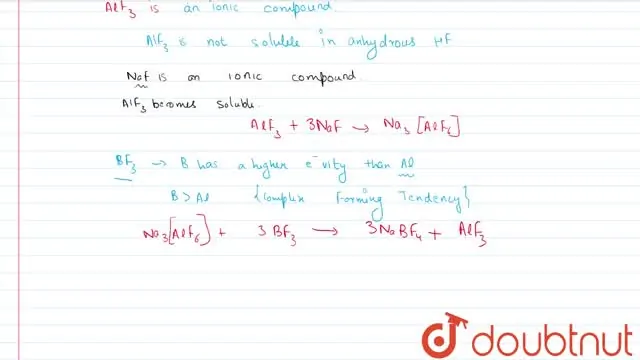AlF3 is insoluble in anhydrous HF but dissolves on addition of NaF.AlF3 precipitates out of the resulting solution when gaseous BF3 is bubbled through. Give reasons.
Hydrogen fluoride (HF) is a covalent compound and has a very strong intermolecular hydrogen-bonding. Thus, it does not provide ions and aluminium fluoride (AlF) does not dissolve in it. Sodium fluoride (NaF) is an ionic compound and when it is added to the mixture, AlF dissolves. This is because of the availability of free F–. The reaction involved in the process is:
AlF3+3NaF→Na3[AlF6]Sodium hexafluoroaluminate(III)
When boron trifluoride (BF3) is added to the solution, aluminium fluoride precipitates out of the solution. This happens because the tendency of boron to form complexes is much more than that of aluminium. Therefore, when BF3 is added to the solution, B replaces Al from the complexes according to the following reaction:
Na3[AlF6]+3BF3→3Na[BF4]+AlF3
Related Playlists
Similar Questions
AlF3 is insoluble in anhydrous HF but dissolves on addition of NaF.AlF3 precipitates out of resulting solution when gaseous BF3 is bubbled through. Give reasons.
View SolutionAlF3 is insoluble in anhydrous HF but when little KF is added to the compound it becomes soluble. On addition of BF3,AlF3 is precipitated. Write balanced chemical equation.
View SolutionAlF3 is insoluble in andydrous HF but when little KF is added to the compounds it becomes soluble. On addition of BF3,AlF3 is precipitated Write the balanced chemical equation .
View SolutionThe addition of NaOH to Cr3+ solution produces the precipitate of
View SolutionWhen of the following precipitate is soluble in excess of NH3 solution?
View Solution(i) A white solid mixture of two salts containing a common cations in insoluble in water. It dissolves in dilute HCl producing some gases (with effervescence) that turn an acidified dichromate solution gren. After the gases are passed through the acidified dichromate solution, the emerging gas turns baryta water milky.
(ii) On treatment with dilute HNO3, the white solid gives a solution which does not directly give a precipitate with a BaCl2 solution but gives a white precipitate when warmed with H2O2 and then treated with a BaCl2 solution.
(iii) The solution of the mixture in dilute HCl, when treated with NH4Cl,NH4OHand an Na2HPO4 solution, gives a white precipitate.
Q. The white precipitate obtained in (iii) consists of:View Solution(i) A white solid mixture of two salts containing a common cations in insoluble in water. It dissolves in dilute HCl producing some gases (with effervescence) that turn an acidified dichromate solution gren. After the gases are passed through the acidified dichromate solution, the emerging gas turns baryta water milky.
(ii) On treatment with dilute HNO3, the white solid gives a solution which does not directly give a precipitate with a BaCl2 solution but gives a white precipitate when warmed with H2O2 and then treated with a BaCl2 solution.
(iii) The solution of the mixture in dilute HCl, when treated with NH4Cl,NH4OHand an Na2HPO4 solution, gives a white precipitate.
Q. The white precipitate obtained in (ii) indicates the presence of a:View SolutionOn addition of conc HNO3 to the aqueous solution of common
salt, sodium chloride crystallises out. Give reason.View SolutionA mixture consists (A) (red solid) and (B) (colourless solid) which gives lilac colour in flame.
(a)Mixture gives black precipitate (C) on passing H2S(g).
(b)(C) is soluble in aquaregia and on evaporation of aquaregia and adding SnCl2 gives greyish black precipitate (D).
The salt solution with NH4OH gives a brown precipitate.
The sodium extract gives yellow precipitate with AgNO3 solution which is insoluble in dilute ammonia solution.
Identify (A) and (B), and the precipitates (C) and (D).View SolutionPH3 forms bubbles when passed slowly in water but NH3 dissolves.(TorF)
View Solution


